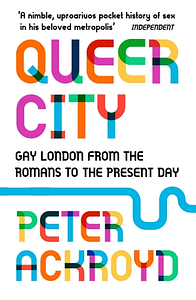Take a photo of a barcode or cover
informative
fast-paced
I may or may not have picked this up because Nick Nelson has it on his bedside table in Heartstopper, and I honestly cannot imagine a queer history book Nick would enjoy less than this one. Maybe I just wasn't the right audience for this book, or I lack the preliminary historical context needed to get more out of it than I did.
Its almost titilating indulgence in describing sexual encounters of adults with minors, power imbalances, and SA/violence sets an uncomfortable tone. Contextualizing his research would have improved the issue, but Ackroyd didn't have room to do so, instead attempting to speed-run 2,000 years of history in less than 300 pages. The result is cartoonish depictions of queer folks that read like tabloid bylines rather than academic writing. Multiple volumes or a narrower scope would have honored queer London much better. I found the sections covering the 20th century especially interesting, but, again, disappointingly rushed and superficial. I also disliked how difficult it was to distinguish between facts and the author's own speculation. Footnotes directly citing his sources would have preferrable to just a bibliography.
If you're looking for an alternative reading choice by an English author, I highly recommend the engaging and nuanced Before We Were Trans by Kit Heyam.
Its almost titilating indulgence in describing sexual encounters of adults with minors, power imbalances, and SA/violence sets an uncomfortable tone. Contextualizing his research would have improved the issue, but Ackroyd didn't have room to do so, instead attempting to speed-run 2,000 years of history in less than 300 pages. The result is cartoonish depictions of queer folks that read like tabloid bylines rather than academic writing. Multiple volumes or a narrower scope would have honored queer London much better. I found the sections covering the 20th century especially interesting, but, again, disappointingly rushed and superficial. I also disliked how difficult it was to distinguish between facts and the author's own speculation. Footnotes directly citing his sources would have preferrable to just a bibliography.
If you're looking for an alternative reading choice by an English author, I highly recommend the engaging and nuanced Before We Were Trans by Kit Heyam.
Graphic: Homophobia, Pedophilia, Sexual assault, Sexual violence
Really, it's scraping 1.5 stars, but I thought I would be kind. Frankly, I had to skimread the last few pages just so it was finished - Ackroyd seems to think that he has some clever, poignant closing statements about queerness, queer experiences and the overall shifts in queer identity, when in reality they are nonsensical at best and deluded at worst, seeming to have absolutely no reflection on history at all or even Ackroyd's own book.
It can be said without a doubt that Ackroyd (or at least, his researchers, acknowledged in a brief paragraph in the back of the book) has done a lot of research. The pages are packed with disjointed, meaningless quotes and snippets of information that serve little purpose other than a signalling of "Look at me! I've read so much and I can prove it! Aren't I clever?!" Isn't "choosing your sources" one of the first lessons they teach you in Non-fiction Writing 101?
The overall effect is of being bombarded with useless information. Rather than, as the opening chapter may suggest, painting a picture of the queer experience from the Roman era Londinium through to modern day London, Ackroyd had at some point decided that he was far more interested in simply listing every single case of anal sex in London feom the 1600s-1900s. He may as well have put the entire book in bullet points like a Wikipedia list article, and saved us all some time wading through his tedious writing.
In fact, I think the entire book can be summarised in this brief quote in the closing pages:
"With the right to marry and adopt, gay people seem less involved with the rush and roll of cruising and carousing [...] and are more concerned with settling down within the domestic environment [...] legal acceptance has bred a certain placidity."
I'm sorry, what?
This comes, mind you, after several accounts of same-sex "marriages" between both men and women, which Ackroyd seems convinced were all scams, rather than anything resembling love or a desire for stability. It's also an example of the "detached-ness" of Ackroyd's writing: he seems to have run his entire manuscript through a synonym generator to make it appear more academic. At best, the effect is disorientating (much like his chronology, which hops around like a rabbit on steroids) and confusing; at worst, it is downright dehumanising. A word of advice, Mr. Ackroyd: repeatedly calling gay men "amorous males" makes me feel like I'm reading a nature documentary, and not an account of actual, real human beings. I understand that occasionally, Ackroyd also makes an attempt at humour. It very rarely works.
The 1.5 star rating comes from the few nuggets of interesting information in the book: how the court fashions changed with the comings and goings of different monarchs with varying levels of acceptance towards homosexuality, the descriptions of "mollies" who seem to resemble very early drag, and other accounts of crossdressing and gender nonconformity (although Ackroyd rarely admits it as such - he seems to live under the preposterous notion that "transsexualism" - and here I would like to remind the audience that this book was published in 2018 - is a 21st century invention).
So, whilst this book is not all terrible, it is a waste of time. If you're searching for something entertaining, informative and, well, less exasperating to read, I'd suggest bypassing this particular volume and heading straight for GoodReads' "reccomendations" section below.
It can be said without a doubt that Ackroyd (or at least, his researchers, acknowledged in a brief paragraph in the back of the book) has done a lot of research. The pages are packed with disjointed, meaningless quotes and snippets of information that serve little purpose other than a signalling of "Look at me! I've read so much and I can prove it! Aren't I clever?!" Isn't "choosing your sources" one of the first lessons they teach you in Non-fiction Writing 101?
The overall effect is of being bombarded with useless information. Rather than, as the opening chapter may suggest, painting a picture of the queer experience from the Roman era Londinium through to modern day London, Ackroyd had at some point decided that he was far more interested in simply listing every single case of anal sex in London feom the 1600s-1900s. He may as well have put the entire book in bullet points like a Wikipedia list article, and saved us all some time wading through his tedious writing.
In fact, I think the entire book can be summarised in this brief quote in the closing pages:
"With the right to marry and adopt, gay people seem less involved with the rush and roll of cruising and carousing [...] and are more concerned with settling down within the domestic environment [...] legal acceptance has bred a certain placidity."
I'm sorry, what?
This comes, mind you, after several accounts of same-sex "marriages" between both men and women, which Ackroyd seems convinced were all scams, rather than anything resembling love or a desire for stability. It's also an example of the "detached-ness" of Ackroyd's writing: he seems to have run his entire manuscript through a synonym generator to make it appear more academic. At best, the effect is disorientating (much like his chronology, which hops around like a rabbit on steroids) and confusing; at worst, it is downright dehumanising. A word of advice, Mr. Ackroyd: repeatedly calling gay men "amorous males" makes me feel like I'm reading a nature documentary, and not an account of actual, real human beings. I understand that occasionally, Ackroyd also makes an attempt at humour. It very rarely works.
The 1.5 star rating comes from the few nuggets of interesting information in the book: how the court fashions changed with the comings and goings of different monarchs with varying levels of acceptance towards homosexuality, the descriptions of "mollies" who seem to resemble very early drag, and other accounts of crossdressing and gender nonconformity (although Ackroyd rarely admits it as such - he seems to live under the preposterous notion that "transsexualism" - and here I would like to remind the audience that this book was published in 2018 - is a 21st century invention).
So, whilst this book is not all terrible, it is a waste of time. If you're searching for something entertaining, informative and, well, less exasperating to read, I'd suggest bypassing this particular volume and heading straight for GoodReads' "reccomendations" section below.
Lots of interesting details and archival gems but the book really does lack much of a structure. It seems more like a compilation of notes for a history than a history itself, but nonetheless, still fascinating
mint throughout, and then at the end decided to be grumpy and pessimistic about where “we” are now as a “community” rather than happy that no one is being arrested, pilloried, murdered, ruined, ad naus anymore like they were for the previous 250 pages. weird flex dude
DNF at 50%. Poorly organised avalanche of facts and speculation with some interesting gems in there but an unenjoyable reading experience to get to them.
informative
slow-paced
I enjoyed the full history of it but some parts are a bit dense.
hopeful
informative
reflective
sad
medium-paced
Caveat: I received this book as a Goodreads Giveaway. Very interesting material, good historical detail. I agree I the reviews who say the book is choppy in the writing and not feeling. I was impressed by the details of research and that so many obscure tid bits could have been found in diaries and such.
informative
fast-paced
funny
informative
reflective
medium-paced
though occasionally feeling like it indulges in (rather than simply explains) the worst parts of historical queerness—SA, paedophilia, pederasty, etc.—this is a digestible, funny (in an EXCEEDINGLY dry, British way), and intriguing portrait of queerness in London. the locating of events to still-existing places (St. Paul's, Leadenhall Market) is grounding. the best bits were discussions of queer love and radical acceptance (like marriage between women! surprisingly common?). also, this book really emphasizes queer men's culture, though, as Ackroyd himself pints out, that's likely a result of historical (and lbr contemporary) centring of men and men's experiences.



